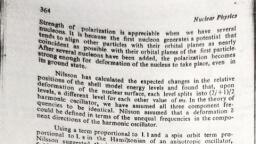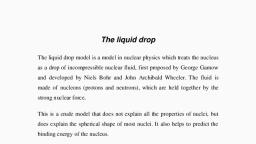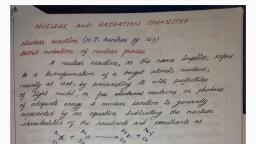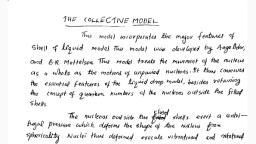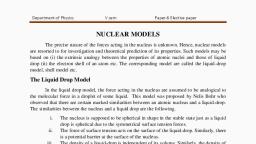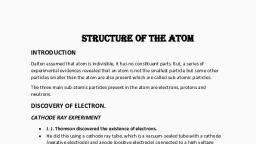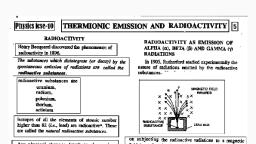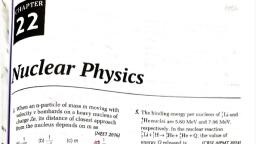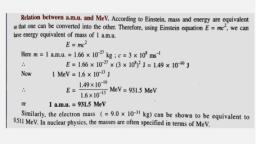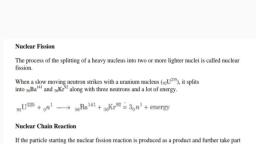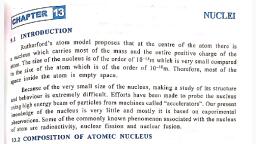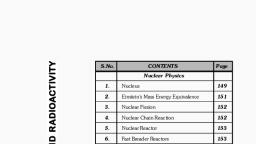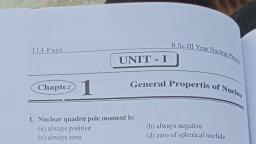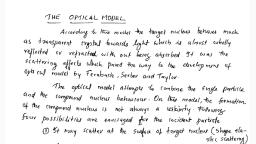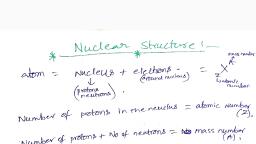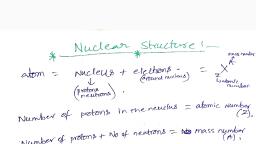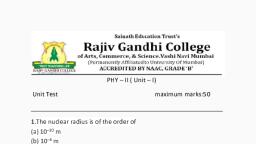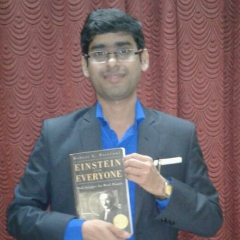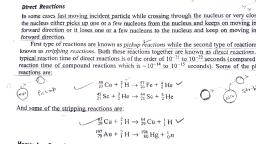Page 1 :
Nuclear Models, , 9.1. INTRODUCTION, , The small sizé of the nucleus and the fact that the forces concerned do not appear else where, make the theoretical approach to nuclear structure more difficult than the theoretical approach to electronic structure. There are many isolated facts which will require explanation when we adopt any nuclear model. Few of them are (a) Why, do nuclei emit «-particles and 8-particles when these are known to, contain only protons and neutrons 2 (6) Why is the binding energy per, nucleon almost constant? (c) Why are the 4n nuclei perticularly, stable? (d) How do we explain the existence of excited states of, nuclei? (e) How dowe explain the Geiger-Nuttall rule ? (f) How do, we interpret the special properties of nuclei such as stability, spin,, magnetic moment, etc., , The characteristics of nucleon-nucleon forces in conjunction, with the Pauli exclusion principle cause nuclear matter to exhibit, apparently contradictory behaviour. The macroscopic properties., such as constant density and constani dindine energy pe: nucleon., Tesemble those of a drop of liquid. On the other haad, the microscopic properties, such as nucleac wave functions and particle, motions, resemble thoss of a weakly interacting gas. The reosemblance toudrop of liguid serves as the basis for the liquid drop, model and collective mode i 3 Miaiice too weakis imeer, acting gas serves as the has - gat madsland tte sh, model. ., , 9.2, FERMI GAS MODEL S, oO: ine motion c*, til is taken to be, , , , , , , , This emphasizes tas tree pirucic Ciaracte, nucleons within the nucieus. in tais mods: the nu, composed of a degenerate Fermi gas of neutrons and protons. The, gas is considered degenerate because all the particles are crowded, into the lowest possible states in a manner consistent with the, Tequirements of the Pauli principle. For each type of particle, the, gas may be characterized by the K. B. of the highest filled state., the Fermi energy. The nucleons move freely within a spherical, potential well of the proper diameter with depth adjusted so that, , . 334, , , , , , ae
Page 2 :
Nuclear\Korce 333., , , , the Fermienergy raises the highest lying nucleons up to: Be, binding energies. ‘, , . 1 y, Let us neglect for the moment the electrostatic charge of th, , e pro, tons and suppose that our nucleus has N=Z=A/2. The well is ned, separately with nucleons of each type, allowing just two particles of, a given type with opposite spin to each cell in phase space of volume, A®. According to the assumption of Fermi statistics, the number of, neutron states per unit momentum interval is, , AN [dp =2.4np2V [(20h)*=Vp2/n8 3, eA), Here Vis the volume of the nucleus. If pr [=2ME,)*/"] is the, , limiting momentum, below which all the states are filled, then the, , number of neutrons occupying momentum states upto this maximum, momentum is given by :, , DP Vv, N= je d= st pe (2), or pr=(G2°)'8H (NIV), (3), , , , : ' Bey \eP, a 2) 8/sh ee (o (4), , Fermi energy Ey (3x?) sae y --(4), For a spherical well of radius 1.2% 10-15 41/3 m filled with N, neutrons, in a crude approximation Z=N=A/2, we have Er=30, MeV. Since it is known experimentally from photo-disintegration, experiments that the binding energy of the least bound neutron, (ionization Potential) of average heavy nuclei is8 MeV. Hence the ©, neutron gas is contained in a potential energy well of depth~38 Mev., , _ For protons the situation is Similar except for the potential, barrier. However, a nucleus contains fever protons than neutrons, and hence the maximum K. F., of the protons is less than that, of the neutrons, If the electroStatic repulsion between the pro, tons is consideted, the symmetry, is destroyed and the model must, involve two separate gases contained in two different wells and, having different energy levels., The levels are occupied to the, same height if the nucleus is Bstable. Otherwise a Sequence of, B-decays will occur until this, , A, BMev, , , , , , , , situation is reached. The well | 25%, depth for the proton gas is con- w 8, siderably less than that for the Fig. 9.1. Fermi gass Model., , neutrons, which can be explained by the fact that the neutrons feel, only the attractive nuclear forces, but the protons feel in addition, the repulsive Coulomb potential of their mutual electrostatic interactions. Thus for stable nuclei there wil be an excess of neutrons —, because of the greater depth of neutron well. :
Page 3 :
R36 ¥ Nuclear Physics, , jeti f the, , The Perini gine model is not useful for the prediction of the, , detained Properties of tow ing statee of nuclei ever Saelon, , Padionctive Gecny processes. Though the model cuggests tha to die, , Collisions will not often transfer small amount of ott a ‘6 are, Duclos, Becater the mucicon momentum states near the orig, , led din the, fr A nuclean in An excited state ie no longer ee more, Fermi gus. tt interactions with the remaining nucleons be, , and more ‘HpOrtent with increasing excitaion energy. Hence oi, excited states of nuclei ate many bedy states in which the ene By is, shared by many Particles. An excitea nucleus is more like a neers, , condensed material than a nuclens in the ground state. For a Sine, hua see OF many particles the only practical way of descri ok, Nuclear excitation is in the statistical apptoach. This statistica, , a ‘S applicable even to unbound states for medium and heavy, Ructe;, , 8.3. Ligurp DROP MODEL, , A nuclear model usually associated with the semi-empirical, mass formula was Suggested by Bohr in 1937. In this model the finer, features of nuclear forces are ignored but the Strong internucleon, attraction is stressed. The essential assumptions are + (1) The nucleus, poDsists of incomp-essible matter hat R=R,A'!* ; (2) The nuclear, forex is identical for ces MAUS 40-that = Rl force saturates., , Usone might inquire whether a nucleus can be represente asa, Crystalline #Beregate of nucleons. But it gives that the zero point, vibrations of the nucleons about their mean rest Positions would be, 60 voilent for stability. Hence the individual nucleons must be able, to move about within the nucleus much as does an atom of a liquid, an¢ One might. there ore, think of a nucleus as being like a small, drop of liquid: Such a model is thus known as liquid drop modei., , , , , , , , , , , , , , , Orce of 2 liquid; (2) The nucléons behave in a manner similar to, , that oP molecules in a.liquid ; (3) The fact that the density of nuclear, matter is almost independent of A shows resemblance to liquid drop, , , , , , , , , , , w —Gensity of a liquid is independent Of the size of the drop ;, 4) The constant binding eneray per nu is analogous to the ~, tetent heat of yaporisation ; (5) The uclei by the, , smussion of particles is analogous. £vaporisation of molecules, fr Surface of liquid ; (6) Th ° nuclei” orresponds ty”, , rom the y, , internal #! vibrations of The Ormation of, com utfeus and ab: m, Oi condensation, , arding “particles are, Inspite of these. sumilatities we see following differences ;, , , , Molecules attract oite anol at distances larger than the diseute, of the electron ghells Strongly when the distance is A, than the size of the el orbits, Nuclear forces are attra, , , , within the smaller range, range of ii, Sl
Page 4 :
Nuclear Models, , K.E. of the molecules in the liquid is of the order of O1} ev,, he corresponding de Broglie wavelength is 5X10" m which ig, much smaller than the intermolecular distances. The average KR, ne of nucleons in nuclei is of tho order of 10 MeV, the Corresponding, re Ast6x10"* m, which is of the order of inter-nucleon distances, c Hence the motion of the molecules in the liquid is of classical ©, © } char: whereas in nuclei the motion of the nucleons is of quantum, , y | ‘charac, , , , Semi-empirical formula gives no information about any other, Properties of nuclei than their energies and the Z/A ratio, In-esti., mating the properties of the excited states of nuclei, one has to, consider deformation of a: spherical drop giving rise to Periodic, Oscillations of the surface,, , A’ spherical drop (a nucleus) of radius Ry is deformed. If R, (8, 9) be the distance of the deformed surface from the centre at an, angle 8, 3, the difference can be expressed as, , a oo 1, j 78, )=R0,4)—R=B F din Yon (8, 9) «.(5), , 1=0 m=—, , } To make the problem simpler, let us consider cylindrically, | Symmetric deformations for which m=0 and gio oscillate harmonically in time as, , B= COS (wit), ---(6), , The characteristic frequency w is determined by the dynamics, of the vibration. The surface tension opposes the surfaze deformation. Since the liquid is incompressible, the waves at the surface, implies motion within the liquid. The wavelength of surface vibra, } tions of a liquid drop is given by the relation *X=Ri/l. The mass. p, Participating in the vibration is equal to the mass of the outer shell, of thickness 3, given by :, , 4=M(3X/R). (7), , The kinetic energy in the vibration T=hug?. +-.(8), , Due to the wave of amplitude g: and wavelength X, the plane surface, 5 increases by an amount *, , AS=4 (q/x)* S. ()), The change in surface energy of the drop AS« is equal to the, potential energy, Hence we get, , a ——_—, , , , , , , , AEs =} (gi/)? Sa=4K gi. +--(10), From relations (8) and (10), we get the frequency pe, = (K/y)!"=(4nal®/3M)", 0), , he |?, The ‘specific properties of the spherical surface cheat the |, into /(/—1) (+2). The surface tension coefficient a can, in terms of surface energy E:=a, A?" as &
Page 5 :
338 “WMublear'Phystes., , An R= Fy a, At Or &=as/4rR2 a te 1.92), Hence relation (11) becomes ate BA PETE, C11) (14-2) (@/3R@ MAYER, oun -nA(13), , This gives us. too high ‘Value of the excitation energy. |, «w is reduced by the Coulomb effect, as 8y. The frequency, , ly) a pa ~, , =| I(/-1 { Uef2) im ee, , iw [ (oI 42)- 5 heim A (14), where y is the ratio between the Coulomb energy Ec=3Z%e?/4mey R, and the surface tension cnergy E,=4naR*=a, 42/8. This equation, leads to somewhat smaller frequencies for heavier nuclei, but is, insufficient to represent the actual level distances,, , Relation (14) shows that the frequency becomes imaginary, when y is larger than acertain limiting value ‘{c. Its smallest value is, 2 for I=2. Hence condition for stability against surface deformation, is, , ¥e(= Ee/Es=0.0474 ZA)<2 or Z*/A<42.2. ---(15), , We, therefore, ¢xpect in this model that the nuclei near the limit of, Z*/A split into two parts y the addition: supply of small amounts, , Ofenergy. =) | a1 2, We summarise the results: The liquid dro model not onl;, , gives atomic masses and biadin \ q, predicts a-an emission nding energy formula, , roperties. he bi, , ocs not include closed shell ‘ects, but it can be used to provide a, , Base Tine from which shell effects can . is model is, , able To explain certain features of nuclear sion, butis not very, ig the actual excited states as it gives too large, , successful in describin gives too large, , level distances. This model Is the forerunner of the collective model of, yuclear Structure, orms ic oD ics © compound nucleus formation in nuclear reactions,, , 9,4, SHELL MODEL ~~), , In_the liquid drop_model we have emphasized the properties, of nuclear matter and have said nothing about single nucleons. This, is a great departure from the atomic model where the emphasis is on, the motion of the electrons in the field rovided by the nucleus. Now, questions are: Can be nucleons exist in well ordered quantum, controlled nuclear shells 7 Is there any evideace for the grouping o}, nucleons into shells 7Can quantum numbers similar to n, J, S,j be, ays to the nucleus ? For certain numbers of neutrons or protons,, called magic numbers, nuclei exhibit special characteristics of stability, reminiscent of the properties shown by noble gases among the atoms., Nuclei in which either NV or Z is equal to one of these magic numbers, , 82, 126) show certain paticulars that are not under, andable in terms of the liquid drop model. We will see that the, magic numbers of the nucleons can be explained with a shell model, of the nucleus, Evidently protons and Deutrons in the nucleus are, not all equivalent as had been assumed in introducing the liquid, , ‘Re te

